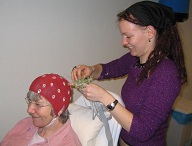COLLEGE PARK, Md. – What does love look like? A dozen roses delivered on an ordinary weekday? Breakfast in bed? Or just a knowing glance between lovers?
While outward displays of love are fairly easy to discern, a researcher in the College of Behavioral and Social Sciences is taking a decidedly “inward” approach to documenting this most complex of human emotions.
Sandra Langeslag, an expert in biological psychology, is using brain-imaging tools such as electroencephalography (EEG) and functional magnetic resonance imaging (fMRI) to identify and assess the neurocognition of romantic love.
“I want to understand how the brain works when humans are attracted to one another,” says Langeslag, a postdoctoral research fellow in the Laboratory of Cognition and Emotion.
By associating specific brain impulses with psychological data related to romantic love, Langeslag is at the forefront of research bridging the gap between emotion — a state of mind derived from one’s circumstances — and cognition, which is acquiring knowledge through thought and experience.
“The traditional [scientific] view is that cognition and emotion are two different things,” says Luiz Pessoa, a professor of psychology and director of the lab. “But we believe they interact to a great extent — that there aren’t two completely separate sets of brain areas related to each.”

A volunteer is hooked up and ready to begin Dr. Langeslag's research looking at how the brain works when humans are attracted to one another. (Image courtesy Sandra Langeslag)
Langeslag’s research began a decade ago while still an undergraduate in her native Netherlands. She already had a strong interest in biological psychology, and decided to explore the biological aspect of romantic infatuation and attachment when she herself fell in love.
“That got me to thinking, ‘Wow, what’s happening to me? Why do I feel the way I feel?'” she recalls.
Langeslag wrote her master’s thesis on the physiological traits of romantic love, conducting research on fellow students in the Netherlands who had identified themselves as being in love. The testing involved a battery of questionnaires combined with brain imaging data supplied by EEG, which measures electrical impulses, and fMRI, which measures precise areas of blood flow.
By showing the test participants a series of images, whether of their beloved, a friend or a stranger, Langeslag was able to detect a specific brainwave pattern called P3 that represents “motivated attention.” The P3 brainwave was very pronounced when subjects where shown pictures of their own partner, she says, leading her to believe that people pay close attention to their sweethearts, even in the face of distractions like friends dropping in or an attractive stranger entering their field of view.
Langeslag did similar research while pursuing her doctorate in emotional memory, also in the Netherlands. Now at Maryland, she continues to analyze her data collected from overseas while she and Pessoa examine another aspect of cognition and emotion: how a person’s reasoning ability is affected by negative stimuli, such as the threat of receiving an electrical shock.
Ultimately, Langeslag believes her neurocognitive research on romantic love will help other scientists studying the biological aspects of romantic behavior.
“Love is not a psychiatric disorder, but people that are in love are kind of crazy,” she says. “Although we’re not looking to cure anyone from being in love, we should continue to explore every aspect of this that we can.”
– By Tom Ventsias
*Source: University of Maryland

